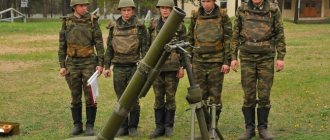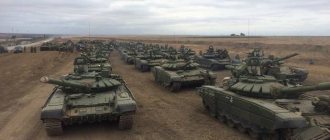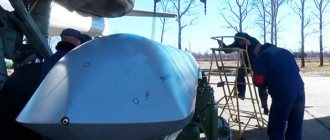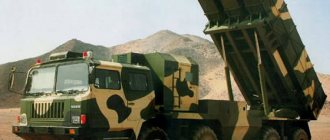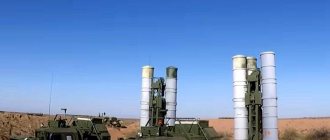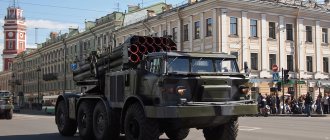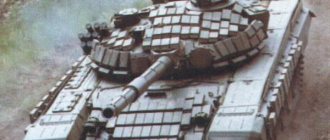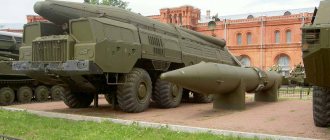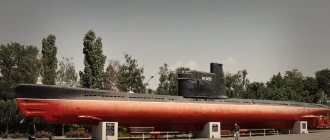Military air defense systems and complexes in service with the leading countries of the world are quite diverse. Their main purpose is the direct protection of units and groupings of ground forces from enemy air attack weapons on the battlefield, reserves, as well as military facilities for combat and logistics support. The experience of recent local conflicts has clearly shown: the likelihood of destroying the air defense system of a country under attack through the massive use of high-precision weapons is very high. Thus, the only effective means of repelling air strikes from low and medium altitudes are military air defense systems.
The majority of military air defense assets are short-range anti-aircraft missile systems (SAMs), man-portable anti-aircraft missile systems (MANPADS) and anti-aircraft artillery - self-propelled anti-aircraft guns (ZSU) and anti-aircraft artillery systems (ZAK). They are, as a rule, in service with air defense units of the ground forces, for example, anti-aircraft missile battalions of various brigades, divisions or army corps, regiments of army corps and anti-aircraft artillery regiments of divisions, wings of missile defense systems and other formations.
Military air defense systems are mostly highly mobile (self-propelled or towed) anti-aircraft missiles, anti-aircraft artillery or combined (missile-artillery) systems on tracked or wheeled chassis.
Short-range artillery and missile systems (ZSU, SAM, ZRAK, MANPADS), as a rule, are located directly in the combat formations of the covered troops and follow motorized infantry and tanks at distances of up to 300-400 m from the front edge, firing on the move and from short distances stops on targets at low and ultra-low altitudes. In the tactical depth of the troops (up to 30-40 km) there may be military air defense units to combat air defense forces at low and medium altitudes. They are usually armed with short- and medium-range air defense systems that are capable of quickly deploying directly from the march.
Long- and medium-range air defense systems of army or front-line subordination are used to protect operational groupings of ground forces from targets flying at high and medium altitudes. Military air defense units armed with long- and medium-range weapons are usually also armed with short-range air defense systems to cover long-range systems in their short-range “dead zone”.
The main targets for modern military air defense systems are not only airplanes and helicopters, which until recently constituted the main striking force of the air defense forces. but also cruise missiles, air-to-surface missiles, guided bombs, tactical and operational-tactical ballistic missiles. In recent years, unmanned aerial vehicles (UAVs) have been added to this list, being the most difficult targets due to their small size. It is the problem of intercepting tactical and operational-tactical missiles, cruise missiles and UAVs that is fundamental in the creation of promising air defense and missile defense systems.
Launcher 9A83 of the S-300V anti-aircraft missile system
Today, in leading Western countries, there is a certain crisis with modern military air defense systems and complexes. According to the latest concept, it provides for the rapid conquest of dominance in aerospace at the very first stage of an armed conflict. So, most medium- and short-range weapons capable of directly protecting units from air-launched missiles on the battlefield have been withdrawn from service in the last 20 years. They were replaced by long-range zonal and object-based air defense systems (American MIM104 “Patriot”), while short-range air defense systems and MANPADS remained for direct support of ground forces units. True, in recent years, the United States has repeatedly attempted to create its own military air defense systems (for example, the SLAMRAAM program for the Army and Marine Corps), but due to budget cuts they were never put into service.
Launcher 9A82 of the S-300V anti-aircraft missile system
A similar situation has developed with anti-aircraft artillery installations: most of them have been withdrawn from service or remain in small quantities, while the creation of new ones is not envisaged. However, the leading countries of Western Europe - France, Italy, Germany - are creating international consortia in order to develop promising military air defense systems, which are planned to be put into service in the near future. The USA is also showing interest in these works.
In Russia, military air defense systems have traditionally been given very great importance. The large technical reserve left over from the USSR has made it possible in recent years to modernize the air defense systems in service with the Ground Forces to the modern level, as well as to create and adopt new effective systems. In addition, work is actively underway on promising systems that are significantly ahead of similar Western developments and are capable of combating all types of modern explosive weapons.
Fashion tips
In addition, the Russian army is armed with S-300B long-range military air defense systems, which, unlike foreign zonal air defense systems deployed only in pre-designated areas of the theater of operations, can cover operational groupings of troops, quickly advancing in a threatening direction. These complexes have self-propelled chassis with high maneuverability and can move within fronts and quickly deploy immediately, covering troop groups.
In Asian countries there has also been a certain rise in the development of military air defense systems. Thus, Japan and South Korea adopted their own air defense systems and self-propelled guns, which made it possible to get rid of systems previously purchased from the United States. China is also actively working to modernize old and create new military air defense systems, having achieved some success in this direction, although mainly using copying technology.
Russia
The most powerful military air defense system in Russia is the S-300V2 air defense system, which was put into service in 1998 on the basis of the previous modifications of the S-300V/V1. This is a universal multi-channel anti-aircraft missile system for air and missile defense of the front-line Ground Forces. The first version of the complex was developed at NPO Antey (NIEMI) back in 1988 to replace the obsolete 2K11 Krug air defense system in the Ground Forces.
The S-300V2 complex is designed for the defense of important military installations, troop groups and administrative and industrial centers from attacks of all types of aircraft and helicopters, cruise missiles, other aerodynamic air attack weapons, as well as aeroballistic and ballistic missiles for operational-tactical purposes. Its combat operation is ensured day and night in various weather conditions, in difficult jamming conditions and with the massive use of air defense systems.
All combat assets of the complex are placed on unified tracked chassis of the GM-830 type (“Object 831”), which have high maneuverability and maneuverability corresponding to the equipment of the Ground Forces.
Each anti-aircraft missile division consisted of one 9S457 command post, a 9S15M “Obzor-3” all-round radar, a 9S19M2 “Imbir” program review radar (detection of the warheads of ballistic and aeroballistic missiles, loitering jamming aircraft at a range of up to 100 km) and four anti-aircraft missile batteries, each of which included one multi-channel 9S32 missile guidance radar, two 9A82 and four 9A83 launchers, 9A84 (one) and 9A85 (two) launcher-loaders. In addition, the system included technical support and maintenance tools.
A special feature of the S-300V series air defense system is the presence of two types of anti-aircraft missiles and, accordingly, two types of launchers and ROM. Both missiles are partially unified with each other and are made according to a normal aerodynamic design, have the same directional action and weigh 150 kg, but differ in size and maneuverability. The “large” 9M82 missile defense system has an average flight speed of 1800 m/s and a maximum speed of 2400 m/s; “small” rocket 9M83 - 1200 and 1700 m/s, respectively. The maximum permissible overload is 20g. The guidance system is noise-immune, semi-active, radar, with tracking through the missile in the final section and inertial guidance in the middle section of the trajectory. The 9A82 launcher carries two containers with 9M82 missiles, the 9M83 launcher carries four containers with 9M83 missiles; both have a missile guidance station (target illumination).
In design, basic characteristics and operation, the launchers differ only in the device for fixing the TPK in the starting position and the mechanical part of the radar. The rockets are launched vertically.
The zone of destruction of aerodynamic targets of the S-300V air defense system is up to 100 km in range and from 25 m to 30 km in height, the zone of destruction of ballistic targets in range is 30 km (for the 9M82 missile) and 40 km (for the 9M83), in height - from 1 to 25 km. The maximum speed of targets hit is 3000 m/s. The S-Z00V2 modification has an interception range increased to 160 km and an altitude of up to 40 km.
The deeply modernized C-300B4 system began to be delivered to the Russian army in 2015. It also has two types of missiles, but its combat capabilities have increased significantly. Thus, the reach of the “large” 40N6 missile has been increased to 400 km, and the interception altitude to 185 km. Moreover, it has a hyperspeed corresponding to 7.5 M. The “small” missile has a range of 150 km. The S-300V4 ensures the destruction of all existing and future types of aerospace attack weapons, including tactical ballistic missiles (at a range of up to 200 km).
The guidance system of the new missiles is inertial, with radio correction in the middle section of the trajectory and semi-active high-precision homing in the final section. The use of missiles with a high-precision inertial control and radio correction system made it possible to use a radar seeker to intercept even the smallest targets with an ESR equal to 0.02 m2.
Self-propelled air defense system 9K37 "Buk-M1"
The modernized S-300V4 air defense system includes: 9S457M KP, 9S15M2, 9S19M2 and 9S32M radars, 9A83M launchers (four missiles) and 9A82M (two missiles), as well as 9A85M and 9A84M ROMs. The anti-aircraft missile division is capable of simultaneously firing at up to 24 targets, aiming 48 missiles at them. The rate of fire of each launcher is 1.5 s. The entire complex is transferred from standby mode to combat mode in 40 seconds, and the deployment time from the march takes 5 minutes. The division's ammunition load is 96-192 anti-aircraft missiles.
The 9K37 Buk-M1 medium-range air defense system, which is in service with the Russian Ground Forces and the armies of nine other countries, was put into service in 1983. Its development was carried out by the Research Institute of Instrument Engineering named after V.V. Tikhomirov. In 1998, the modernized 9K37M1-2 Buk-M1-2 complex, equipped with the new 9M317 anti-aircraft missile, entered service. These two medium-range air defense systems (more than 350 launchers) are the most effective means of medium-range military air defense of the Russian army. They are designed to combat maneuvering aerodynamic air targets and tactical ballistic missiles at low and medium altitudes under conditions of intense radio countermeasures in simple and adverse weather conditions.
Self-propelled firing system of the Buk-M2E complex on the MZKT-6922 chassis
The Buk-M1-2 complex includes: 9S470M1-2 command post, 9S18M1-1 “Dome” target detection radar, six 9A310M1-2 launchers and the same number of 9A39M1-2 launcher-loaders. All self-propelled vehicles of the complex are made on GM-569 tracked chassis. The launcher includes: a circular rotation platform with four missiles on beam guides with vertical guidance, a missile guidance radar, a digital computer, a television-optical sight, a laser rangefinder, and a friend-or-foe identification system. The launcher-loader carries an ammunition supply of eight missiles and, if necessary, can launch four of them from its guides controlled through the nearest launcher.
The missile defense system is made according to a normal aerodynamic configuration, has a mass of 720 kg, the mass of the warhead is about 70 kg, and the engine is solid fuel. The firing range of the complex is from 3 to 45 km for aircraft, for tactical ballistic missiles - up to 20 km, for cruise missiles - 20-26 km, the affected area in height is from 15 m to 25 km, the speed of targets hit is up to 1100 m/ s, the number of simultaneously fired targets is 22. The 9S18M1-1 three-dimensional all-round radar provides detection and identification of air targets at ranges of up to 110-120 km and transmission of target designation to the command post. The command post simultaneously tracks up to 46 targets in a zone with a radius of 100 km and issues target designations for self-propelled firing systems.
In 2008, a modernized complex was created - 9K317 Buk-M2. The number of targets simultaneously fired by it was increased to 24, and the aircraft engagement zone was increased to 50 km. In addition, the likelihood of hitting cruise missiles and helicopters is increased; reaction time is only 10 s. In addition to the 9S510 KP, 9S18M1-1 (or 9S112) radar, 9A317 PU and 9A316 ROM, the 9S36 illumination and guidance radar with an antenna on a lifting mast was introduced into the complex.
Based on the basic air defense system, an export complex was developed - 9K317EK "Buk-M2EK" on the wheeled chassis of the MZKT-69221 (8x8) tractor, as well as the ship-based air defense system "Uragan"; In Belarus, the 9K37MB Buk-MB variant appeared.
In 2016, Russia put into service the deeply modernized 9K317M Buk-MZ complex with the new 9M317M missile, designed to destroy modern and advanced surface-to-air missiles at a range of up to 70 km and an altitude of up to 35 km, as well as at ultra-low altitudes of 5 m. A distinctive feature of the new air defense system is the presence of TPK for missiles and an increase in their number on the launcher to six.
Self-propelled firing system 9A317 ZRS S-300V
One of the most effective short-range military air defense systems is the Russian 9K331 Tor-Ml and its modifications. This is an all-weather tactical complex designed to cover the first echelons of the Ground Forces and important facilities from attacks from modern cruise missiles, guided aircraft missiles, UAVs, glide bombs, airplanes and helicopters. It can operate in fully automatic mode with independent control of designated airspace and shoot down air targets not identified by the “friend or foe” system.
.
The first version of the Tor complex was created at NIEMI and put into service in 1986. In 1991, the Tor-M1 modification entered service with the troops, which became dual-channel in target and had a more effective missile and updated equipment. Since 2013, the modernized 9K331MU Tor-M1-2U complex has been supplied. Around the same period, air defense systems appeared on the 9K331MK Tor-M2K wheeled chassis and the modular version 9K331MKM Tor-M2KM, adapted for placement on various types of platforms.
All modifications of the Tor air defense system are placed on the Object 355 tracked chassis, which contains: target detection radar, phased array guidance radar, and optical tracking system. computer, vertical launch installation for eight missiles and other equipment. The antenna and launch devices form a single structure on a rotating platform. The target acquisition radar can simultaneously detect up to 24 targets and track ten of them. For the Tor-M1 variant, the number of detected and recognized targets was increased to 48. The aircraft detection range is 27 km. helicopters - 20 km. UAV - up to 15 km, detection altitude - up to 6 km.
Combat module of the Tor-M2KM air defense system on the TATA chassis
The solid-fuel rocket is made according to the “duck” design, has a mass of 165 kg, a speed of 700-800 m/s, a warhead mass of 14.8 kg, and a proximity fuse. Firing range - from 1.5 to 12 km, interception altitude - from 10 m to 6 km. The guidance system is noise-proof, radio command, with radar and optical tracking. The reaction time of the complex is: up to 7.4 s - when firing from a position, up to 9.7 s - when firing from a short stop. The 9M331 missile is capable of withstanding overloads of up to 30g and hitting targets maneuvering with overloads of up to 12g.
Combat vehicle 9A331M SAM 9K331M "Tor-M2"
Currently, complexes of this type are in service with the Russian Ground Forces - over 120 air defense systems of various modifications. They are gradually replacing the outdated Osa-AKM and 9K35M3/M4 Strela-10MZ/M4 complexes. In addition, “Torahs” in export version have been supplied to the armies of eight more countries. The deeply modernized 9K331M Tor-M2 complex with the 9M338 missile, which has been in development since 2008, was put into service.
The main distinguishing features of this air defense system are the ability to fire on the move without stopping and twice the ammunition capacity (16 missiles). The 9M338 missile defense system has an enlarged affected area and is highly maneuverable combined with increased guidance accuracy, which allows it to effectively combat small-sized and highly maneuverable surface-to-air missiles and UAVs.
In addition, a version of the 9K331MDT Tor-M2DT air defense missile system has been created for Arctic units, based on the DT-30 two-link tracked transporter. It was first shown at the Victory Parade in Moscow on May 9, 2022.
However, the Russian Ground Forces continue to have in service the Soviet-made self-propelled air defense systems 9KZZMZ Osa-AKM and 9K35M4 Strela-10M4 (approximately 400 vehicles each). They are single-channel in purpose, but due to repeated upgrades, they are limited in their ability to combat some modern EHVs.
The 9KZZ "Osa" air defense missile system was developed at NII-20 of the State Committee for Energy and Energy and was put into service in 1971. The complex was quite compact for its time and was placed on the chassis of a specially designed three-axle all-wheel drive amphibious vehicle BAZ-5937. The 9AZZB combat vehicle had a rotating platform of circular rotation, on which inclined launchers, a missile guidance and target tracking station, an optical sight, and a all-round viewing station were located.
In 1975, the modernized 9KZZM2 Osa-AK air defense system was put into service, and in 1980, the 9KZZMZ Osa-AKM air defense system. The firing range is from 1.5 to 10 km. The target detection station provides detection of fighter-type targets at a range of up to 40 km (at an altitude of 5 km) or 27 km (50 m); a noise-resistant target tracking station can guide up to two missiles at one target. The 9MZZM5 rocket is solid-fuel, designed in a canard design, has a radio command guidance system, launch weight 128 kg, and is equipped with a fragmentation warhead weighing 15 kg. proximity fuse with an actuation radius of 5 m. The marching speed of 1.51 M allows you to intercept targets at speeds of up to 500 m/s (300 m/s in pursuit). The launcher contains six ready-to-launch missiles in square containers. The deployment (collapse) time of a combat vehicle does not exceed 5 minutes. Shooting is only possible from a standing position.
The complex also includes a 9T217B transport-loading vehicle (carries 12 missiles) with a loading crane, built on the same chassis as the BM. Osa complexes of various modifications are available in the armies of another fifteen countries, including neighboring countries. They were repeatedly used in armed conflicts in the Middle East (Lebanon, Syria, Iraq), Africa (Angola, Libya), as well as in Yugoslavia and South Ossetia. In 2003, in Belarus, NPO Tetrahedr developed a modernized version of the air defense system - 9KZZ-1T "Osa-1T" (for export deliveries). The complex was equipped with a new guidance system, which made it possible to hit targets flying at speeds up to 700 m/s at ranges up to 12 km and altitudes up to 7 km; due to the new element base, its noise immunity was increased, the optical-electronic system OES-1T was installed and the degree of process automation.
The 9K35 "Strela-10SV" air defense system was developed at the Tochmash design bureau and put into service in 1976. Unlike the "Osa" air defense system, it could fire on a fire-and-forget basis, since its 9M37 missile had a two-channel seeker with a main photo-contrast guidance mode and spare infrared (in conditions of interference, on oncoming and catch-up courses). At the same time, this complex had a simplified design and worked based on target designation from external sources, which provided it with greater combat stability.
The 9A35 combat vehicle was made on the basis of the MT-LB tracked armored tractor. A circular rotation platform was installed on the roof of its hull with an operator’s seat inside (the operator tracked the target visually), and on top of it were installed two dual guided launchers with square-section missile defense containers and electric drives, as well as a parabolic millimeter range radio range finder antenna. The 9S86 zone assessment equipment with a calculating device determined the position of the target and automatically calculated the angles for the preemptive launch of the missile defense system. The vehicle's body carried a spare ammunition load of four missiles, which the crew reloaded manually.
Srela-10MN air defense missile system combat vehicle
The last Soviet version of the air defense system - 9K35M4 "Strela-10M4" - was put into service in 1989. Its 9MZZZ missile was made according to the "duck" design (like the previous versions 9M31 and 9M37) and was equipped with a solid fuel jet engine. The seeker, in addition to infrared and photocontrast, had an additional interference guidance mode. The launch weight of the missile defense system is 42.5 kg, the weight of the rod warhead is 5 kg, the flight speed is 1.56M, the speed of the intercepted target is 420 m/s (in pursuit of it is 310 m/s), range is 5 km; the fuse had contact and non-contact sensors.
Due to the simplicity of the complex, its various modifications are still in service with the armies of about two dozen countries.
In 2015, the Russian Airborne Forces adopted a modernized version of the Strela-10MN, developed at the JSC Precision Engineering Design Bureau named after A.E. Nudelman". The complex was equipped with a thermal imaging system with automatic target acquisition and tracking, as well as a scanning unit. Modernization is carried out using the existing Strela-10M2/3/4 complexes (more than 50 vehicles have been delivered to the troops). In Belarus, NPO Tetrahedr also developed its own modernized version of the Strela-10T air defense system, equipped with an OES-1TM optoelectronic system, a digital computer and satellite navigation equipment.
In 1982, the 2S6 Tunguska anti-aircraft missile and artillery system, developed at the Tula Instrument Engineering Design Bureau and designed to replace the ZSU-25-4 Shilka, which had become less effective, entered service with the USSR Ground Forces. The complex was intended for air defense of motorized rifle, tank units and subunits on the march and in all types of combat. It ensured the destruction of low-flying small air targets flying at speeds of up to 500 m/s with missiles and artillery weapons. According to the estimates of most domestic and foreign experts, the Tunguska complex has no analogues abroad and until recently was the most powerful anti-aircraft system of its class.
The 2K22 combat vehicle is based on the Object 555 tracked chassis. It includes a turret installation with two double-barreled 50-mm automatic cannons and eight launchers with missile defense systems in the TPK. The target detection radar, tracking radar, friend-or-foe system, optical sight, operator and commander positions, and ammunition of 1,904 rounds are also located there. The crew of the car is 4 people.
The 9M311 rocket is a two-stage rocket, the first stage engine is solid fuel, the second stage is without an engine (the flight proceeds by inertia). The fuse is non-contact, the warhead is equipped with rod striking elements. The missile strike zone in height is up to 3.5 km, in range – from 2.5 to 8 km.
The affected area by anti-aircraft guns is up to 5 km in height and from 0.2 to 4 km in range. The total rate of fire of automatic guns is up to 5000 rounds/min. It is possible to engage ground targets at a range of up to 2 km. The target detection range of the all-round viewing station is up to 18 km, tracking range is up to 15 km.
In 1990, the modernized 2S6M Tunguska-M complex appeared, which included interface equipment with the 9S482M and PPRU-1 control points, which significantly increased the effectiveness of the anti-aircraft battery by distributing targets between installations.
In the second half of the 1990s. a modification 2S6M1 “Tunguska-M1” was developed, adopted by the Russian Armed Forces in 2005. The combat vehicle is built on an improved GM-5975 chassis. The complex uses equipment for receiving automated target designation from a battery command post, increased noise immunity, and also increased the affected area in range to 10 km due to the introduction of the modernized 9M511-1M missile defense system. In 2015, at the International Military-Technical Forum "Army", a modernized 2S6M1 combat vehicle was demonstrated, equipped with a new optical-electronic sighting system with a thermal imager and all-round radar.
Structurally, the anti-aircraft missile and artillery battery includes four Tunguska combat vehicles (platoon) with heavy equipment and support equipment, as well as a platoon of Strela-10 air defense systems. The battery is part of an anti-aircraft division of a motorized rifle or tank regiment.
Combat vehicle 2S6M1 of the Tunguska-M1 complex
The Russian Ground Forces are armed with over 250 Tunguskas of the two latest modifications. In addition, this complex was supplied to the armies of five more countries and was inherited from the USSR by Belarus and Ukraine.
The 9K338 Igla-S MANPADS, put into service in 2002, is the latest modification of the Igla series of systems in service with the Russian army and more than 30 other countries. In terms of mass and distribution, they compete with the American Stinger MANPADS. The complex is designed to destroy low-flying air targets on oncoming and catch-up courses under conditions of exposure to thermal interference. The development was carried out at the Kolomna Mechanical Engineering Design Bureau together with the LOMO enterprise. In the military, Igla replaced the outdated Strela-2M and Strela-3 complexes.
MANPADS "Igla-S" has incorporated all the latest technical solutions of modernized systems of previous types. It has increased the mass of the missile warhead (2.5 kg), and now has the ability to fire small targets such as UAVs and low-flying cruise missiles. The complex includes an anti-aircraft missile in a launch tube. power source, trigger mechanism with an attached “friend or foe” interrogator.
The launch is carried out from the shoulder of the anti-aircraft gunner; the crew consists of two people. The target designation tool is a portable electronic tablet 1L15-1, which displays data on low-flying targets from a higher command post. The missile weighing 11.7 kg is made according to the “duck” design, the guidance system is passive, with a two-channel seeker. The engine is solid fuel. The high-explosive fragmentation warhead is equipped with contact and non-contact fuses. The destruction range is 6 km, the height is from 10 m to 3.5 km. The speed of targets hit on a collision course is up to 400 m/s, on a catch-up course - up to 320 m/s. To most effectively destroy an air target, a few seconds before meeting it, the missile is retargeted from the engine nozzle to the center of the target, piercing the skin and exploding inside it.
In addition to the Igla-S, units of the Ground Forces, Airborne Forces and Marine Corps of the Russian Army are armed with the Igla, Igla-1, Igla-D and Igla-N modifications. There is an “Igla-V” variant with a unified launcher of two or four missiles, designed to arm helicopters and mobile anti-aircraft missile systems (for example, “Luchnik”), as well as a light launcher “Dzhigit” for firing a salvo of two missiles.
Igla missiles are used in the Gibka and Komar shipborne short-range air defense systems.
The newest Russian MANPADS is the 9KZZZ “Verba”, developed at the Kolomna Mechanical Engineering Design Bureau and put into service in 2014. It is designed to destroy low-flying air targets from any angle in a difficult jamming environment, including low-emitting cruise missiles and UAVs.
The Verba complex includes: the 9M336 anti-aircraft missile, the 9P521 launcher, the 1L122 small-sized radar detector and the 1L229V friend-or-foe interrogator. It also includes: mobile control point 9В861, planning module 9С931, reconnaissance and control module 9С932-1, portable fire control module 9С933 (in a brigade set), built-in installation kit 9С933-1 (in a divisional set), anti-aircraft gunner automation kit 9S935 and training aids. The total mass of the complex is 17.25 kg.
Airborne Forces fighter with Verba MANPADS
The missile is made according to the “duck” design, the engine is solid fuel, the warhead is high-explosive fragmentation, with a contact and non-contact fuse. It is equipped with an infrared tri-band noise-immune seeker, including protection against advanced laser jamming systems.
The range of destruction of air targets is from 5 to more than 6 km, the interception altitude is more than 4 km, the speed of the targets hit is up to 400 m/s.
A special feature of the complex is an automated control system that detects single and group air targets with determination of their flight parameters, as well as distribution between anti-aircraft gunners, taking into account their placement.
Based on materials from the magazine “Equipment and Weapons” No. 5 2019
Continuation: Military air defense systems and complexes in service with the leading countries of the world. Part 2
We also read:
- Military air defense systems and complexes in service with the leading armies of the world. Part 3
- C-500 "Prometheus". Creating new weapons
- S-300F "Fort" air defense system
- "Tor-M2KM" - modular air defense system
- Military air defense systems and complexes in service with the leading armies of the world. Part 2
- The S-75 air defense system is the first among equals. Part 4
- The S-75 air defense system is the first among equals. Part 3
- The S-75 air defense system is the first among equals. Part 2
- The S-75 air defense system is the first among equals. Part 1
- Development and role of air defense systems in the air defense system. Part 2
- Precision engineering booms. MANPADS "Strela"
- SAM "Dagger"
- SAM M-1 "Volna"
- SAM M-11 "Storm"
- SAM M-22 "Hurricane"
- SAM M-2 "Volkhov"
- Anti-aircraft missile system "Strela-10"
- Anti-aircraft missile system S-200 "Vega"
✏ Leave a comment
Categories: Military air defense systems and complexes. Author admin ✏ No comments »
SAM systems "Osa", MD-PS, "Tunguska" and "Sosna-RA"
This air defense system was inherited by the Russian Federation and other CIS countries from the USSR. The main target of the Wasp: helicopters, airplanes, cruise missiles and drones. During Soviet times, the air defense system was successfully used in the 1960s. The Osa provided protection for ground forces if the aircraft was designed for medium and low altitude.
A distinctive feature of the MD-PS anti-aircraft missile system is its ability to operate covertly. For this task, the air defense missile system was equipped with optical means with the help of which the MD-PS, using infrared radiation, detects it and targets the missile defense system. The main advantage of the complex is that, thanks to its all-round visibility, it is capable of simultaneously identifying up to fifty targets. Then, from among them, several are selected that are the most dangerous. Then they are destroyed. When aiming a gun, the “fire and forget” principle is applied. The missile is equipped with homing heads that can independently see the target.
The Tunguska anti-aircraft gun missile system provides short-range air defense. Since attack aircraft and helicopters primarily operate at low altitudes, the Tunguska successfully copes with them. Thus, reliable infantry cover is provided in battle. In addition, the target of this air defense system can be floating military and lightly armored ground equipment. If there is no fog or snow, then the Tunguska can shoot both on the move and from a standstill. The air defense system is equipped with 9M311 missiles. The complex is additionally equipped with 2A38 anti-aircraft guns, which operate at an angle of 85 degrees.
SAM "Osa"
Sosna-RA is a light mobile towed anti-aircraft gun missile system. It destroys air targets at altitudes of up to three thousand meters. Compared to the Tunguska, the Sosna-RA is equipped with a 9M337 hypersonic missile, which can shoot down an enemy object at an altitude of 3.5 kilometers. The range varies from 1300 to 8000 meters. Due to the fact that Sosna-RA is relatively light in weight, it can be transported on any platform. The Russian military most often transports the complex using Ural-4320 and KamAZ-4310 trucks.
ZRAK "Buk" and modifications
Since 1970, this complex was still located by the Soviet army. Currently, this anti-aircraft missile system is in Russian service and is listed in the technical documentation as 9K37 Buk. The complex includes the following components:
- command post 9s470;
- firing installation 9A310;
- charging installation 9A39;
- station for target detection 9S18.
Parts of the complex are installed on conventional tracked platforms, which are characterized by high maneuverability. The Buk fires 9M38 anti-aircraft missiles. According to military experts, with the help of such an air defense system it is possible to hit an air target at an altitude of up to 18 km and a distance from the system of up to 25 km. In this case, the probability of an accurate hit is 0.6. After modernization, a new air defense system was created - Buk-M1. If we compare it with its analogue, then this option has a higher probability of destruction and an increased area. In addition, the Buk-M1 has a function that allows you to recognize a flying object. The new model is much more protected from anti-radar missiles. The main purpose of the air defense system is to shoot down helicopters, airplanes, enemy drones and cruise missiles.
In the 1980s a new version has appeared - 9M317, firing modern missiles. The use of 9M317 required engineers to make improvements to the design of the complex. A missile with smaller wings and increased range at an altitude of 25 km. The main advantage of the 9M317 is that its fuse operates in 2 modes. Upon contact with the missile or at a certain distance from it, the target will be destroyed. The self-propelled fire unit has new equipment, thanks to which it detects 10 targets simultaneously and can eliminate four of them, which it considers the most dangerous.
ZRAK "Buk"
In order to completely replace outdated electronics with modern digital equipment, military engineers developed the Buk-M3 air defense system. The rocket itself was also replaced. Now shooting is carried out with the modern 9M317M, which has high characteristics. Despite the fact that there is no specific information about this complex yet, experts suggest that such an air defense system can shoot down a flying object at an altitude of more than 7000 meters with a hit probability of 0.96.

